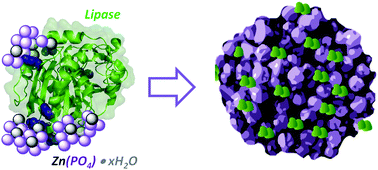Understanding the functional properties of bio-inorganic nanoflowers as biocatalysts by deciphering the metal-binding sites of enzymes†
Abstract
The biomineralisation of metal phosphates is a promising approach to develop more efficient nanobiocatalysts; however, the interactions between the protein and the inorganic mineral are poorly understood. Elucidating which protein regions most likely participate in the mineral formation will guide the fabrication of more efficient biocatalysts based on metal-phosphate nanoflowers. We have biomineralised the lipase from Thermomyces lanuginosus using three calcium, zinc and copper phosphates to fabricate different types of bio-inorganic nanoflowers. To better understand how the biomineralisation process affects the enzyme properties, we have computationally predicted the protein regions with a higher propensity for binding Ca2+, Cu2+ and Zn2+. These binding sites can be considered as presumable nucleation points where the biomineralisation process starts and explain why different metals can form bio-inorganic nanoflowers of the same enzyme with different functional properties. The formation of calcium, copper and zinc phosphates in the presence of this lipase gives rise to nanoflowers with different morphologies and different enzymatic properties such as activity, stability, hyperactivation and activity–pH profile; these functional differences are supported by structural studies based on fluorescence spectroscopy and can be explained by the different locations of the predicted nucleation sites for the different metals. Among the three metals used herein, the mineralisation of this lipase with zinc-phosphate enables the fabrication of bio-inorganic nanoflowers 34 times more stable than the soluble enzyme. These bio-inorganic nanoflowers were reused for 8 reaction cycles achieving 100% yield in the hydrolysis of p-nitrophenol butyrate but losing more than 50% of their initial activity after 6 operational cycles. Finally, this heterogeneous biocatalyst was more active and enantioselective than the soluble enzyme (ee = 79%(R)) towards the kinetic resolution of rac-1-phenylethyl acetate yielding the R enantiomer with ee = 84%.

- This article is part of the themed collection: Journal of Materials Chemistry B Emerging Investigators


 Please wait while we load your content...
Please wait while we load your content...